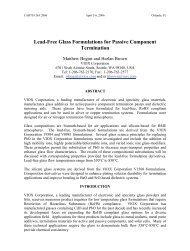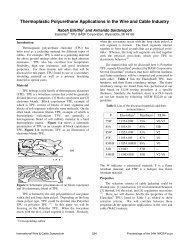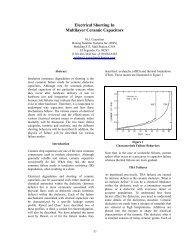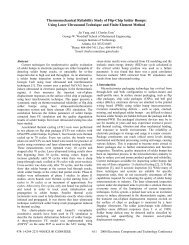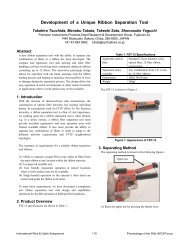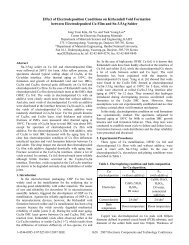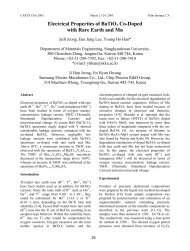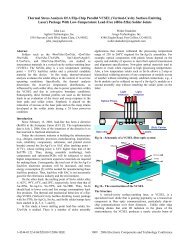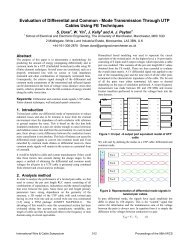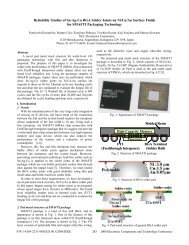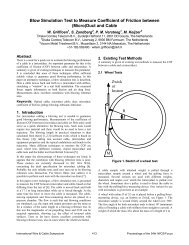Failure Analysis of Dielectric Breakdowns in Base-Metal Electrode ...
Failure Analysis of Dielectric Breakdowns in Base-Metal Electrode ...
Failure Analysis of Dielectric Breakdowns in Base-Metal Electrode ...
Create successful ePaper yourself
Turn your PDF publications into a flip-book with our unique Google optimized e-Paper software.
CARTS International 2013 March 25-28, 2013<strong>Failure</strong> <strong>Analysis</strong> <strong>of</strong> <strong>Dielectric</strong> <strong>Breakdowns</strong><strong>in</strong> <strong>Base</strong>-<strong>Metal</strong> <strong>Electrode</strong> Multilayer Ceramic CapacitorsRonald J. WeachockDell System Federal Government,Inc.NASA Goddard Space Flight CenterGreenbelt, MD 20771Ronald.j.weachock@nasa.govDavid (Donhang) LiuMEI Technologies, Inc.NASA Goddard Space FlightCenterGreenbelt, MD 20771Donhang.liu-1@nasa.govAbstractLeakage current measurements <strong>of</strong> BaTiO 3 -based X7R multilayer ceramic capacitors (MLCCs)with base-metal electrodes (BMEs) have revealed three dist<strong>in</strong>ct failure modes: avalanchebreakdown (ABD), thermal runaway (TRA), and slow degradation. <strong>Failure</strong> analysis (FA) wasperformed for a number <strong>of</strong> BME capacitors that failed with the aforementioned three failuremodes. The samples that failed with ABD had damage sites that were easily found and that werecharacterized by the existence <strong>of</strong> <strong>in</strong>completely burned b<strong>in</strong>der particles that were surrounded bytransverse cracks that extended through several layers <strong>of</strong> electrodes from the damaged site, clearlya sequence caused by thermal damage. The samples that failed with TRA also had a particle-likeprocess<strong>in</strong>g flaw with high carbon content, but the flaw was smaller than that <strong>of</strong> the ABD failuresamples. The failure site was also surrounded with extensive transverse cracks that extendedthrough many dielectric layers. Degraded dielectric and conglomerates <strong>of</strong> nickel spheres werealso revealed, <strong>in</strong>dicat<strong>in</strong>g a severe thermal event that generated excessive heat and that resulted <strong>in</strong>the melt<strong>in</strong>g <strong>of</strong> the local dielectric and electrodes. There is no fundamental physical differencebetween ABD and TRA failures for BME capacitors. The failure mode is a comb<strong>in</strong>ation <strong>of</strong> ABDand TRA and is referred to as “catastrophic.”The failure analysis on the samples that failed with a slow degradation <strong>in</strong>dicates a failure processthat can be described as follows: The electromigration <strong>of</strong> oxygen vacancies not only gives rise toa gradual <strong>in</strong>crease <strong>of</strong> leakage current aga<strong>in</strong>st stress time, but also changes the <strong>in</strong>itial stoichiometry<strong>of</strong> BaTiO 3 gra<strong>in</strong>s and causes the local hollow<strong>in</strong>g and melt<strong>in</strong>g <strong>of</strong> dielectric gra<strong>in</strong>s and the formation<strong>of</strong> cracks. The molten dielectric dissolves the <strong>in</strong>ternal nickel electrodes and transports the nickelalong the transverse cracks, which causes the resistive short. Some <strong>of</strong> the cracks with dielectricdegradation will eventually result <strong>in</strong> a catastrophic failure. The failure process <strong>in</strong>volves alocalized high temperature that can melt both dielectric and nickel. There was no evidence <strong>of</strong>nickel migration <strong>in</strong> the BME capacitors, even under highly accelerated life stress conditions.The failure analysis <strong>in</strong>dicates that failure mechanism <strong>in</strong> BME capacitors with BaTiO 3 dielectricscan be more accurately described as a two-stage dielectric wearout that beg<strong>in</strong>s with a slowdielectric degradation, characterized by a gradual <strong>in</strong>crease <strong>in</strong> leakage current with stress time, andfollowed by a thermally dom<strong>in</strong>ated catastrophic breakdown (either ABD or TRA).
IntroductionThree dist<strong>in</strong>ct failure modes were revealed from time-dependent dielectric breakdown leakagecurrent measurements <strong>of</strong> BaTiO 3 -based X7R multilayer ceramic capacitors with base-metalelectrodes (BMEs): the so-called avalanche breakdown (ABD), thermal runaway (TRA), and slowdegradation. The measurements were performed by collect<strong>in</strong>g leakage current data as a function<strong>of</strong> stress time dur<strong>in</strong>g highly accelerated life stress test<strong>in</strong>g (HALST). This study was conducted <strong>in</strong>order to evaluate the reliability <strong>of</strong> BME capacitors and access their suitability for space flightapplications [1].The concepts <strong>of</strong> ABD and TRA were first <strong>in</strong>troduced for describ<strong>in</strong>g failure modes for ceramiccapacitors with precious-metal electrodes (PMEs) as early as 1984 [2].ABD failures are normally caused by extr<strong>in</strong>sic defects with<strong>in</strong> the dielectric, such as cracks, voids,or other pre-exist<strong>in</strong>g process<strong>in</strong>g flaws. ABD observed <strong>in</strong> semiconductor devices is typically apurely cha<strong>in</strong>-reaction electronic process that will cause a sudden, catastrophic breakdown <strong>in</strong> whichthe temperature rise is almost negligible [3]. When the leakage current was recorded aga<strong>in</strong>st time,it was found that the ABD can occur at extremely low leakage current levels and that the timefrom the onset <strong>of</strong> breakdown to the f<strong>in</strong>al catastrophic burn<strong>in</strong>g <strong>of</strong> the device is <strong>in</strong> the range <strong>of</strong> nanotomicro-seconds for semiconductor devices. However, this time measurement for most <strong>of</strong> theBME capacitors with ABD-like failures was <strong>of</strong>ten <strong>in</strong> milliseconds or even longer [1].TRA failures are usually caused by <strong>in</strong>tr<strong>in</strong>sic defects that represent the <strong>in</strong>homogeneity <strong>in</strong> thedielectric composition or microstructure, or even <strong>in</strong> the morphology. When a DC voltage isapplied, the <strong>in</strong>tr<strong>in</strong>sic defects will <strong>of</strong>ten cause a local <strong>in</strong>crease <strong>of</strong> current and therefore an <strong>in</strong>creas<strong>in</strong>glocalized temperature. S<strong>in</strong>ce for most oxide-based dielectrics the leakage current <strong>in</strong>creases withtemperature, a local <strong>in</strong>crease <strong>of</strong> temperature will result <strong>in</strong> an <strong>in</strong>crease <strong>of</strong> current and will cause afurther temperature <strong>in</strong>crease. As a result, a positive feedback loop is formed that will eventuallycause the thermal breakdown <strong>of</strong> the dielectric. An example <strong>of</strong> a microstructure anomaly whichcould cause a TRA failure is the over-fir<strong>in</strong>g <strong>of</strong> the dielectric, result<strong>in</strong>g <strong>in</strong> the formation <strong>of</strong> a lowresistanceBaTiO 3 gra<strong>in</strong> [4].Slow degradation failures are characterized by a gradual <strong>in</strong>crease <strong>of</strong> leakage current aga<strong>in</strong>st stresstime until a failure criterion is reached (100µA <strong>in</strong> this study). This failure mode is unique forBME capacitors that normally were s<strong>in</strong>tered <strong>in</strong> a reduc<strong>in</strong>g atmosphere and resulted <strong>in</strong> a highconcentration <strong>of</strong> oxygen vacancies. The degradation under a DC field <strong>in</strong>volves electromigrationand accumulation <strong>of</strong> oxygen vacancies across the dielectric layers towards the cathode. There isalso a pileup <strong>of</strong> oxygen vacancy at the cathode side <strong>of</strong> the gra<strong>in</strong> and with<strong>in</strong> each BaTiO 3 gra<strong>in</strong>,which results <strong>in</strong> BaTiO 3 gra<strong>in</strong>s becom<strong>in</strong>g locally more conductive [5,6].Four BME capacitors that failed dur<strong>in</strong>g HALST with the aforementioned three failure modes wereselected and processed for failure analysis. The objective was to reveal possible correlationsbetween dielectric breakdown failure modes and the physical characteristics at the failure sites.All FA samples were from the same manufacturer lot and had the same product part number. Two<strong>of</strong> the capacitors had ABD failures, one had a TRA failure, and the fourth failed with a slowdegradation.
Construction <strong>Analysis</strong> and HALST Test<strong>in</strong>g <strong>of</strong> BME Capacitors for <strong>Failure</strong> <strong>Analysis</strong>Commercial BME capacitors from manufacturer B with a designated part number <strong>of</strong> B08X56416were selected for construction analysis prior to the HALST. The capacitor is 0.56µF and 16V,with an EIA chip size <strong>of</strong> 0805, and was made with a BaTiO 3 -based X7R dielectric.Five as-received fresh BME capacitors from the same production lot were cross-sectioned foroptical scann<strong>in</strong>g electron microscope (SEM) and energy-dispersive X-ray (EDX) <strong>in</strong>spection tocheck for possible extr<strong>in</strong>sic process<strong>in</strong>g defects such as cracks, voids, or delam<strong>in</strong>ation. Thecapacitor samples were etched with diluted Hydrogen Fluoride (HF) for the purpose <strong>of</strong> del<strong>in</strong>eat<strong>in</strong>gdetails on the construction <strong>of</strong> the capacitor, the dielectric microstructure, and the possibleexistence <strong>of</strong> cracks <strong>in</strong> the dielectric layers before the SEM and EDX exam<strong>in</strong>ations.Figure 1 shows the low-magnification SEM images that have been used to determ<strong>in</strong>e the capacitorgeometry and the overall quality <strong>of</strong> the product. The cross-section SEM images reveal a uniformstructure without obvious process<strong>in</strong>g flaws, with the exception <strong>of</strong> some <strong>in</strong>ternal electrode pull-outcaused by the de-process<strong>in</strong>g <strong>of</strong> the samples. The construction <strong>in</strong>formation was exam<strong>in</strong>edaccord<strong>in</strong>g to Electronic Industries Alliance (EIA) Standard EIA-496.Typical high-magnification SEM images are shown <strong>in</strong> Figure 2. The dielectric layer appears to bedense and uniform, with an average layer thickness <strong>of</strong> 4.2µm and an average gra<strong>in</strong> size <strong>of</strong> 0.36µm,with a maximum <strong>of</strong> 0.4µm measured. No dielectric cracks, either long-range or short-range, wereobserved <strong>in</strong> any <strong>of</strong> the samples. Some m<strong>in</strong>or voids could be observed <strong>in</strong> the dielectric matrix(<strong>in</strong>dicated by arrows).Table I summarizes construction and microstructure <strong>in</strong>formation for this BME product. Thereliability figure <strong>of</strong> merit was evaluated us<strong>in</strong>g an empirical formula that was developed earlier forscreen<strong>in</strong>g commercial BME capacitors for high-reliability applications [7]:, (1)Figure 1. Low-magnification cross-section SEM images <strong>of</strong> BME capacitor B08X56416 forconstruction analysis. No process<strong>in</strong>g flaws were revealed, with the exception <strong>of</strong> some <strong>in</strong>ternalpull-out due to sample de-process<strong>in</strong>g.
Figure 2. High-magnification cross-section SEM images <strong>of</strong> BME capacitor B08X56416 reveal auniform microstructure. Arrows <strong>in</strong>dicate occasionally observed voids <strong>in</strong> the dielectric.In this equation, d is the average dielectric thickness, is the maximum gra<strong>in</strong> size that is equalor smaller than d, N is the total number <strong>of</strong> dielectric layers, and α is the empirical parameter thattypically equals 6. The calculated value <strong>of</strong>from Eq.(1) <strong>in</strong>dicates this BMEproduct is acceptable for high reliability applications [7].Table I. Information on the construction and microstructure <strong>of</strong> the BME capacitor from this studyCapacitor IDConstruction InformationEnd Marg<strong>in</strong> Side Marg<strong>in</strong> Cover Plate No. <strong>of</strong> <strong>Dielectric</strong> LayersB08X56416 170 µm 100 µm 365 µm 82Microstructure InformationCapacitor ID <strong>Dielectric</strong> Thickness Avg./Max. Gra<strong>in</strong> SizeNo. <strong>of</strong> Gra<strong>in</strong>Stack<strong>in</strong>gB08X56416 4.2 µm 0.36 µm/0.4µm 11.67 99.994%The as-received BME capacitor B08X56416 was mounted on a custom pr<strong>in</strong>ted circuit board(PCB) for HALST test<strong>in</strong>g under various accelerated voltage and temperature comb<strong>in</strong>ations. Theleakage current as a function <strong>of</strong> stress time was also monitored and recorded for the purpose <strong>of</strong>determ<strong>in</strong><strong>in</strong>g the failure modes. In this study, the failure criterion was set such that a BMEcapacitor will be considered a failure if its leakage current reaches 100µA. Figure 3 shows typicalleakage current measurement results <strong>of</strong> BME capacitors after HALST. Three failure modes asdescribed <strong>in</strong> this report are also illustrated. Details on the procedure <strong>of</strong> proposed HALST methodhas been described <strong>in</strong> reference [1].Table II summarizes the HALST conditions and correspond<strong>in</strong>g failure modes with respect to thoseshown <strong>in</strong> Figure 3. The DC resistance <strong>of</strong> the failed BME capacitors was also measured prior tosample preparation for failure analysis. In general, the parts with TRA and slow degradationfailures showed low resistance with an occasional short, and those that failed with ABD <strong>of</strong>tenfailed with an electric short.
<strong>Failure</strong> Criterion: 100µAAvalanche(ABD)ThermalRunaway(TRA)SlowDegradationFigure 3. Three dist<strong>in</strong>guishable failure modes observed <strong>in</strong> a typical leakage current measurement<strong>of</strong> BME capacitors.Results <strong>of</strong> <strong>Failure</strong> <strong>Analysis</strong>Dur<strong>in</strong>g FA sample preparation, the electrically failed BME capacitors were mounted on testfixtures that allowed electrical access to the end term<strong>in</strong>ation through wire contacts. The testfixture support<strong>in</strong>g each capacitor was positioned <strong>in</strong> an epoxy mount<strong>in</strong>g cup to allow the alternatelystacked layers <strong>of</strong> electrodes to be exposed by sequential de-layer<strong>in</strong>g <strong>of</strong> the sample and exposure <strong>of</strong>a vertical multilayer cross- sectional view <strong>of</strong> the dielectric and electrodes. Preparation <strong>of</strong> thefixture <strong>in</strong> this manner also allowed cont<strong>in</strong>uous monitor<strong>in</strong>g <strong>of</strong> the capacitors’ resistance value as thecapacitors were meticulously de-processed.
Table II. HALST Test conditions and failure modes <strong>of</strong> FA samples <strong>in</strong> this <strong>in</strong>vestigationNumber HALST Test Conditions <strong>Failure</strong> modes Resistance (Ω)SN1 155 o C/140V Avalanche (ABD)
Figure 7. High-magnification SEM photo and correspond<strong>in</strong>g EDX map <strong>of</strong> the damage site <strong>in</strong>SN3. EDX mapp<strong>in</strong>g <strong>of</strong> the area shows a high concentration <strong>of</strong> carbon at the damage site.2. BME Capacitors That Failed with TRACapacitor SN4 was found to have failed with a resistive short that measured 245Ω. SN4 showed aconstant resistance value as the de-process<strong>in</strong>g analysis progressed through the capacitor. An<strong>in</strong>frared (IR) camera was used to isolate the area <strong>of</strong> <strong>in</strong>terest. The resultant IR temperature imag<strong>in</strong>gshowed the location <strong>of</strong> the shorted area. A typical IR image that created a visible hot spot at ~4Vand ~6mA, and a correspond<strong>in</strong>g optical image identify<strong>in</strong>g the failure site and a long-range crackthat traveled through several dielectric layers are shown <strong>in</strong> Figure 9.Figure 8. High-magnification SEM photos near the damage site. Arrows <strong>in</strong>dicate theconglomerates <strong>of</strong> Ni spheres distributed at the damage site and <strong>in</strong>side a transverse crack.
Figure 9. An IR camera image was used to localize the hot spot <strong>in</strong> SN4 by analyz<strong>in</strong>g thetemperature gradient <strong>of</strong> the heat dissipated by the short (left). The correspond<strong>in</strong>g optical imageshows the region isolated by IR images for which a thermal gradient between oppos<strong>in</strong>g electrodes,correspond<strong>in</strong>g to vertical shorts between electrodes, was detected. The red arrows <strong>in</strong>dicate thetransverse crack (right).A high-magnification SEM photo and correspond<strong>in</strong>g EDX map <strong>of</strong> the damage site are shown <strong>in</strong>Figure 10. The failure site morphology looks similar to that observed for SN1 (Figure 5) and forSN3 (Figure 7), but with a smaller feature size. Aga<strong>in</strong>, a localized high carbon concentration andthe formation <strong>of</strong> nickel spheres were both revealed.Figure 11 shows SEM images <strong>of</strong> an area close to the damage site. To better reveal the details <strong>of</strong>the area, both secondary electron mode (electrons show topography <strong>of</strong> a sample) and backscattermode (contrast is due to the difference <strong>in</strong> the atomic numbers <strong>of</strong> the materials) SEM images weretaken. It is <strong>in</strong>terest<strong>in</strong>g to note that at the lower left corner, a pool <strong>of</strong> molten material was formed<strong>in</strong>side an extensive crack, and the conglomerates <strong>of</strong> a number <strong>of</strong> nickel spheres are distributed <strong>in</strong>the molten material. Although the morphology shown <strong>in</strong> Figure 11 is very similar to that shown <strong>in</strong>Figures 6 and 8 for the ABD failures, the transverse crack found <strong>in</strong> SN4 appears to be moreextensive, <strong>in</strong>dicat<strong>in</strong>g that this sample might have experienced a longer and more <strong>in</strong>tense hightemperatureevent prior to fail<strong>in</strong>g.
Figure 10. High-magnification SEM photo and correspond<strong>in</strong>g EDX map <strong>of</strong> the damage site <strong>in</strong>SN4. Arrow <strong>in</strong> EDX map <strong>of</strong> the area <strong>in</strong>dicates the high carbon concentration spot. The molten Nispheres can be clearly identified.Figure 11. SEM images <strong>of</strong> an area close to the damage site. The left SEM photo was taken <strong>in</strong>secondary electron mode, and the right photo was taken <strong>in</strong> backscatter mode. An extensive crackfilled with a molten material can be seen at the lower left corner <strong>of</strong> the image. Arrows <strong>in</strong>dicate theNi spheres distributed <strong>in</strong>side the pool.3. BME Capacitors That Failed with Slow DegradationBME capacitor sample SN2, which failed <strong>in</strong> slow degradation mode, was carefully de-processedus<strong>in</strong>g numerous iterations <strong>of</strong> the steps for material removal. Resistance measurements were takenafter each polish<strong>in</strong>g <strong>in</strong>terval to determ<strong>in</strong>e whether resistance changes were experienced dur<strong>in</strong>g thedestructive process that could <strong>in</strong>dicate that the defect site had been reached or was <strong>in</strong> the process<strong>of</strong> be<strong>in</strong>g exposed. The <strong>in</strong>itial resistance was 960Ω and did not change dur<strong>in</strong>g the material removalprocess. To assist with the identification <strong>of</strong> the failure site, an IR camera was used aga<strong>in</strong> as 4Vwas applied and 4mA was measured to the sample to show the temperature elevation <strong>in</strong> the
damaged area and to allow the camera to obta<strong>in</strong> IR thermograph images and del<strong>in</strong>eate a thermalsite <strong>of</strong> <strong>in</strong>terest. Figure 12 shows the IR optical images that reveal the failure site.Figure 13 shows an SEM image and correspond<strong>in</strong>g EDX map <strong>of</strong> the crack area identified <strong>in</strong>Figure 12. The result clearly shows a nickel bridg<strong>in</strong>g cross<strong>in</strong>g several dielectric layers, and this isbelieved to be the cause <strong>of</strong> the low resistance measured <strong>in</strong> the sample. However, it is not clearwhy such a nickel bridg<strong>in</strong>g did not result <strong>in</strong> a complete electrical short.Figure 12. SN2, which ma<strong>in</strong>ta<strong>in</strong>ed a stable resistive short throughout the analysis, was analyzedus<strong>in</strong>g an IR camera to localize the hot spot at ~4V, 4mA (left). Physical verification <strong>of</strong> the IRimag<strong>in</strong>g hot spot location showed vertical dielectric cracks cross<strong>in</strong>g several <strong>in</strong>ternal electrodelayers (right).Figure 13. High-magnification SEM photo <strong>of</strong> one region <strong>of</strong> a large transverse crack cross<strong>in</strong>gseveral <strong>in</strong>ternal electrodes (left). Photo on the right is the correspond<strong>in</strong>g EDS map, show<strong>in</strong>g nickelbridg<strong>in</strong>g.
To better understand the failure mechanism <strong>in</strong> SN2, the area was etched with dilute HF <strong>in</strong> order todel<strong>in</strong>eate the morphological details. Figure 14 shows SEM images <strong>of</strong> the same area post-etch.The extensive transverse crack was backfilled with a molten material with a conglomeration <strong>of</strong>nickel spheres <strong>of</strong> various sizes. Some hollows <strong>in</strong> the dielectric region can be observed near thecrack. The morphology is clearly a consequence <strong>of</strong> thermal damage that occurred dur<strong>in</strong>g theaccelerated life stress test<strong>in</strong>g.Figure 15 shows a void region when the sample was further de-processed for material removal.The void measured ~25µm long by 8.4µm wide and transverses several dielectric layers.Horizontal and vertical cracks propagate from the void region. Conglomerations <strong>of</strong> nickel spheres(<strong>in</strong>dicated by arrows and confirmed by EDX mapp<strong>in</strong>g) are present <strong>in</strong> and around the void.Various sizes <strong>of</strong> nickel (Ni)spheres transported bymolten materialFigure 14. High-magnification SEM photo <strong>of</strong> the same region shown <strong>in</strong> Figure 13 after diluteacid etch. The transverse crack conta<strong>in</strong>s amorphous-look<strong>in</strong>g material that once appeared to bemolten and that acted as a vehicle for transport<strong>in</strong>g nickel spheres <strong>of</strong> various sizes across oppos<strong>in</strong>gelectrodes.
(a) (c)(b) (d)Figure 15. Optical image (a) and correspond<strong>in</strong>g SEM image (b) <strong>of</strong> a void region due to dielectricdegradation caused by localized heat<strong>in</strong>g. High-magnification SEM image (c), show<strong>in</strong>g an<strong>in</strong>termediate cross-sectional plane with accumulation <strong>of</strong> nickel spheres with<strong>in</strong> the dielectric layerthat was confirmed by EDX mapp<strong>in</strong>g (d).Figure 16 shows SEM images <strong>of</strong> the void region post-HF etch. The dielectric morphology isdel<strong>in</strong>eated and better characterized. Two different types <strong>of</strong> cracks were revealed: (1) cracks withdielectric degradation that are surrounded by hollow BaTiO 3 gra<strong>in</strong>s, and (2) regular stress crackswithout dielectric degradation.Solid arrows <strong>in</strong>dicatecracks with dielectricdegradationDot arrows <strong>in</strong>dicate stresscracks with no evidence <strong>of</strong>dielectric degradationArrows show areas <strong>of</strong>dielectric degradationFigure 16. SEM images <strong>of</strong> void dielectric morphology post-acid etch reveal two types <strong>of</strong> cracks:cracks with dielectric degradation (<strong>in</strong>dicated by solid arrows), and regular stress cracks (<strong>in</strong>dicatedby dotted arrows).
Figure 17 shows SEM images <strong>of</strong> the void region and the approach<strong>in</strong>g void bottom after severaliterations <strong>of</strong> further material removal. The images were taken after the area was etched to exposepossible new evidence <strong>of</strong> secondary defects. The void walls were covered with a th<strong>in</strong> layer <strong>of</strong>amorphous-look<strong>in</strong>g molten material. The large nickel spheres were present <strong>in</strong> and around thewall, which is apparently the consequence <strong>of</strong> nickel segregation and recrystallization aftertemperature had cooled <strong>of</strong>f. There is no other explanation for how such big nickel spheres couldbe formed.NickelFigure 17. SEM images <strong>of</strong> void region after etch. Pools <strong>of</strong> nickel and degradation <strong>of</strong> thedielectric are shown. The <strong>in</strong>ternal surface area <strong>of</strong> the void was not affected by acid etch.Figure 18 shows SEM images <strong>of</strong> a cross-section plane beyond the void region. An extensive longrangecrack with dielectric degradation was revealed. Two selected areas were exam<strong>in</strong>ed withhigh-magnification SEM. The results show: (1) nickel conglomerates can only be found <strong>in</strong> crackswith dielectric degradation; (2) no trace <strong>of</strong> nickels are found <strong>in</strong> stress cracks; (3) nickel spheres arealways distributed on the surface <strong>of</strong> the molten dielectric, and (4) the molten dielectric is alwayssurrounded by hollow BaTiO 3 gra<strong>in</strong>s that are formed by thermal degradation.Figure 19 shows SEM images <strong>of</strong> the damage area post-etch that appears to be <strong>in</strong> the <strong>in</strong>itial stage <strong>of</strong>a dielectric degradation. A needle-like molten dielectric material is bridg<strong>in</strong>g the adjacent nickelelectrodes and is fully <strong>in</strong> contact with the neighbor<strong>in</strong>g nickel material (as <strong>in</strong>dicated by arrows).The molten material is surrounded by hollow BaTiO 3 gra<strong>in</strong>s. The correspond<strong>in</strong>g EDX map showsthat the bridg<strong>in</strong>g material conta<strong>in</strong>s only Ba, Ti, and O. There is no evidence <strong>of</strong> the presence <strong>of</strong>nickel <strong>in</strong> the molten material.High-mag areashown at rightNi electrodeNi conglomerationstransported <strong>in</strong> moltenmaterialHigh-mag areashown belowDegraded dielectricdel<strong>in</strong>eated by etch
High-mag areashown at rightFigure 18. SEM images, show<strong>in</strong>g post-etch dielectric cracks and degradation beyond the voidregion. Ni sphere conglomerations always were found to be distributed on the surface <strong>of</strong> themolten dielectric and to be surrounded by degraded BaTiO 3 gra<strong>in</strong>s.
Figure 19. SEM image (a) shows post-etch dielectric crack and what appears to be <strong>in</strong>itial-stagedegradation. The correspond<strong>in</strong>g EDX map (b) did not reveal any nickel <strong>in</strong> the crack. However,the nickel electrode is fully surrounded by the molten dielectric (<strong>in</strong>dicated by arrows).This observation <strong>in</strong>dicates that dielectric degradation began with the melt<strong>in</strong>g and travel<strong>in</strong>g <strong>of</strong>dielectric materials along the cracks. When the molten dielectric was <strong>in</strong> contact with the nickelelectrode, the nickel began to dissolve <strong>in</strong>to the molten dielectric, and the molten dielectric behavedas a vehicle for transport<strong>in</strong>g the dissolv<strong>in</strong>g nickel along the transverse cracks, which resulted <strong>in</strong> anelectrical short. However, after the temperature had cooled <strong>of</strong>f, the dissolved nickel segregatedfrom the molten dielectric and solidified on the surface <strong>of</strong> molten dielectric to form conglomerates<strong>of</strong> nickel spheres. This observation clearly <strong>in</strong>dicates that there was no nickel migration <strong>in</strong> theBME capacitors, even under highly accelerated life stress conditions be<strong>in</strong>g used <strong>in</strong> this study.This expla<strong>in</strong>s why nickel on the surface <strong>of</strong> molten dielectric never forms a uniform, cont<strong>in</strong>uousconduction phase and why no trace <strong>of</strong> nickel was found <strong>in</strong> any <strong>of</strong> the stress cracks that do not havedielectric degradation. The conduct<strong>in</strong>g cha<strong>in</strong> that bridges the <strong>in</strong>ternal electrode layers was formedby the neck-to-neck connection among the conglomerated nickel spheres, and therefore it onlyexhibited low resistance, but not a complete electrical short.Discussions1. Avalanche and Thermal Runaway <strong>Failure</strong>sAs po<strong>in</strong>ted out earlier, the ABD failure is a purely electronic process <strong>in</strong> which the rise <strong>of</strong> thecrystal lattice (phonon) temperature is normally negligible [3, 8]. ABD failures <strong>in</strong> SN1 and SN3had easily identifiable damage sites, characterized by the existence <strong>of</strong> <strong>in</strong>completely burned carbonb<strong>in</strong>der particles, and surrounded by a significant number <strong>of</strong> cracks with dielectric degradation andstress cracks without dielectric degradation. These cracks <strong>of</strong>fshoot several dielectric layers fromthe damage site, clearly a consequence <strong>of</strong> thermal damage.SN4, which failed with TRA, revealed a local hot spot when an IR camera was used to map thetemperature distribution <strong>in</strong> the ceramic body. A high carbon conta<strong>in</strong><strong>in</strong>g spot was also identified atthe damage site, but it was much smaller <strong>in</strong> size when compared to that found <strong>in</strong> SN1 and SN3 for
ABD failures. The failure site was also surrounded with extensive transverse cracks that traveledthrough many layers <strong>of</strong> <strong>in</strong>ternal nickel electrodes. Degraded dielectric and conglomerates <strong>of</strong>nickel spheres were also revealed, which is a typical result from a thermal event that generatedheat high enough to melt both the local dielectric and the electrodes.The ABD and TRA failure modes have been proposed and applied to describe the differentfeatures <strong>of</strong> dielectric breakdown <strong>in</strong> SiO 2 gate dioxide [8]. The TRA was also applied to expla<strong>in</strong>the junction breakdown <strong>in</strong> bipolar devices. Both ABD and TRA failures can be clearly separatedand modeled for SiO 2 materials [9]. However, the similarity <strong>in</strong> physical characteristics amongSN1, SN3, and SN4 <strong>in</strong>dicates that there is no observed fundamental physical difference betweenABD and TRA failures for these BME capacitors. The failure mode <strong>in</strong> these BME capacitors canbe viewed as a comb<strong>in</strong>ation <strong>of</strong> both ABD and TRA. The reason for this is that the thermalconductivity <strong>of</strong> SiO 2 is at least 50 times higher than that <strong>of</strong> ceramic BaTiO 3 , and the thermaldiffusivity <strong>of</strong> SiO 2 is ~78 times higher than that <strong>of</strong> ceramic BaTiO 3 . The relatively poor thermalproperties <strong>of</strong> BaTiO 3 are the true reason that makes ABD failures more thermal runaway-like andTRA failures more avalanche-like <strong>in</strong> BME capacitors with BaTiO 3 dielectric. As a result, theABD and TRA failures shown <strong>in</strong> Figure 3 were <strong>of</strong>ten found to be experimentally <strong>in</strong>dist<strong>in</strong>guishablefor BME capacitors. Both <strong>of</strong> these failure types are generally referred to as “catastrophic”failures.In a previous report, an effort was made to separate ABD and TRA failures us<strong>in</strong>g measuredleakage current data <strong>in</strong> order to better understand the failure mechanisms <strong>in</strong> BME capacitors [10].However, as more experimental leakage current data were presented and analyzed, the differencebetween ABD and TRA failures appears to be virtually <strong>in</strong>dist<strong>in</strong>guishable. The similar failuremechanism for ABD and TRA that is revealed <strong>in</strong> the present study confirms this previoushypothesis.2. A Two-Stage <strong>Dielectric</strong> Wearout <strong>in</strong> BME CapacitorsThe failure analysis results shown <strong>in</strong> Figures 18 and 19 <strong>in</strong>dicate that slow degradation beg<strong>in</strong>s withthe electromigration <strong>of</strong> ionized oxygen vacancies that changes the local stoichiometry <strong>of</strong> BaTiO 3gra<strong>in</strong>s and causes the local hollow<strong>in</strong>g and melt<strong>in</strong>g <strong>of</strong> BaTiO 3 gra<strong>in</strong>s and the formation <strong>of</strong> cracks.The molten dielectric dissolves the <strong>in</strong>ternal nickel electrodes and behaves like a vehicle fortransport<strong>in</strong>g the nickel along the transverse cracks and results <strong>in</strong> a reduction <strong>in</strong> resistance. Some<strong>of</strong> the cracks with dielectric degradation will eventually result <strong>in</strong> a catastrophic failure.Another issue with respect to the molten dielectric <strong>in</strong> slow degradation failures was brought up bythis study: The local temperature for a slow degradation failure must be at least as high as themelt<strong>in</strong>g po<strong>in</strong>t <strong>of</strong> nickel (1455 o C), so that nickel electrodes can be molten and transported with themelt<strong>in</strong>g dielectric material. The melt<strong>in</strong>g temperature <strong>of</strong> BaTiO 3 is ~1612 o C, accord<strong>in</strong>g to thephase diagram. This melt<strong>in</strong>g po<strong>in</strong>t <strong>of</strong> BaTiO 3 can be reduced to a eutectic po<strong>in</strong>t <strong>of</strong> ~1320 o C if theBaTiO 3 is TiO 2 -rich [11]. Highly oxygen-deficient, non-stoichiometric BaTiO 3 gra<strong>in</strong>s may alsoexhibit a significantly low melt<strong>in</strong>g temperature that is even lower than that <strong>of</strong> nickel. Further<strong>in</strong>vestigation and experiment evidence are needed to determ<strong>in</strong>e whether slow degradation failurescan reach such a high local temperature.<strong>Base</strong>d on the FA results, the failure mechanism <strong>in</strong> BME capacitors with a BaTiO 3 dielectric mightbe better described by a two-stage dielectric wearout that <strong>in</strong>itiated with a slow dielectricdegradation, characterized by a gradual leakage current <strong>in</strong>crease aga<strong>in</strong>st stress time, followed by athermally dom<strong>in</strong>ated catastrophic breakdown (either ABD or TRA). When the failure criterion is
set with respect to a leakage current level (100µA <strong>in</strong> this study), some BME capacitors will reachthe failure level with a catastrophic failure, and some will fail prior to the occurrence <strong>of</strong> acatastrophic breakdown. This modified two-stage dielectric breakdown model for BME capacitorswith X7R dielectrics is illustrated <strong>in</strong> Figure 20.SummaryFigure 20. Two-stage dielectric wearout failure modes is proposed for describethe dielectric breakdown behaviors <strong>in</strong> BME capacitors.FA results <strong>of</strong> four BME capacitors that failed with three different failure modes were presentedand discussed. The follow<strong>in</strong>g conclusions are based on the f<strong>in</strong>d<strong>in</strong>gs:The failure analysis <strong>in</strong>dicates that the failure modes <strong>in</strong> BME capacitors with BaTiO 3 dielectricscan be more accurately described as a two-stage dielectric wearout that beg<strong>in</strong>s with a slowdielectric degradation, characterized by a gradual leakage current <strong>in</strong>crease with stress time,followed by a thermally dom<strong>in</strong>ated catastrophic breakdown (either ABD or TRA).All samples that failed with ABD and TRA had similar damage characteristics: an <strong>in</strong>completelyburned carbon b<strong>in</strong>der particle, adjacent to significant transverse cracks. However, the damage site<strong>in</strong> ABD failures is larger than that <strong>in</strong> TRA failures. The similarity <strong>in</strong> the physical characteristicsfor ABD and TRA failures <strong>in</strong>dicates that there is no fundamental physical difference betweenABD and TRA for BME capacitors. The failure mode <strong>in</strong> these BME capacitors is a comb<strong>in</strong>ation<strong>of</strong> ABD and TRA and is “catastrophic” <strong>in</strong> general.The FA on the sample that failed with a slow degradation suggests the follow<strong>in</strong>g failure process:With a gradual <strong>in</strong>crease <strong>of</strong> leakage current, the electromigration <strong>of</strong> oxygen vacancies changes the<strong>in</strong>itial stoichiometry <strong>of</strong> BaTiO 3 gra<strong>in</strong>s and causes the local hollow<strong>in</strong>g and melt<strong>in</strong>g <strong>of</strong> dielectricgra<strong>in</strong>s, as well as the formation <strong>of</strong> cracks. The molten dielectric dissolves the <strong>in</strong>ternal nickelelectrodes and behaves like a vehicle to transport the nickel along the transverse cracks and results<strong>in</strong> the resistive short. This study <strong>in</strong>dicates that there was no nickel migration <strong>in</strong> the BMEcapacitors, even under highly accelerated life stress conditions. Some BME capacitors with slow
degradation will reach the failure level with a catastrophic failure, and some will fail prior to theoccurrence <strong>of</strong> a catastrophic breakdown. The failure process <strong>in</strong>volves a localized high temperaturethat can melt both dielectric and nickel.Significant amount <strong>of</strong> cracks are revealed for every failed BME capacitor, regardless <strong>of</strong> the failuremodes. The cracks can be divided <strong>in</strong>to two groups: cracks with dielectric degradation, and regularstress cracks. S<strong>in</strong>ce no any type <strong>of</strong> cracks was revealed dur<strong>in</strong>g the construction analysis <strong>of</strong> freshunits, the observed cracks are the consequence <strong>of</strong> the failure, not the root cause.AcknowledgementsThe authors are thankful to the NASA Electronic Parts and Packag<strong>in</strong>g (NEPP) Program Managers,Michael Sampson and Ken LaBel, for their support and encouragement. The authors also expresstheir gratitude to Michael Sampson and Bruce Me<strong>in</strong>hold for review<strong>in</strong>g the manuscript. Theauthors are also thankful to the GSFC Code 562 Parts <strong>Analysis</strong> Laboratory for technical support.References:1. D. Liu, “Highly Accelerated Life Stress Test<strong>in</strong>g (HALST) <strong>of</strong> <strong>Base</strong>-<strong>Metal</strong> <strong>Electrode</strong>Multilayer Ceramic Capacitors,” CARTS proceed<strong>in</strong>g, 2013 (<strong>in</strong> this proceed<strong>in</strong>g)2. B. Rawal and N. Chan, “Conduction and <strong>Failure</strong> Mechanisms <strong>in</strong> Barium Titanate <strong>Base</strong>dCeramic Under Highly Accelerated Conditions,” Proceed<strong>in</strong>g <strong>of</strong> Electronic ComponentsConference, New Orleans, pp. 184, (1984)3. J.F. Scott, B. Melnick, L. McMillan, and C. Paz de Araujo, “<strong>Dielectric</strong> Breakdown <strong>in</strong>High-e Films for USLI DRAMs,” Integrated Ferroelectrics, 3, pp. 225, (1993)4. M.J. Cozzol<strong>in</strong>o, “Electrical Short<strong>in</strong>g <strong>in</strong> Multilayer Ceramic Capacitors,” CARTSproceed<strong>in</strong>g, pp. 57, (2004)5. G.Y. Yang, E.C. Dickey, C.A. Randall, etc., “Oxygen Nonstoichiometry and <strong>Dielectric</strong>Evolution <strong>of</strong> BaTiO 3 . Part I----Improvement <strong>of</strong> Insulat<strong>in</strong>g Resistance with Reoxidation,”J. Appl. Phys. 96 [12], pp. 7492, (2004)6. G.Y. Yang, E.C. Dickey, C.A. Randall, etc., “Oxygen Nonstoichiometry and <strong>Dielectric</strong>Evolution <strong>of</strong> BaTiO 3 . Part II----Insulation Resistance Degradation Under Applied DCBias,” J. Appl. Phys. 96 [12], pp. 7500, (2004)7. D. Liu and M. Sampson, “Some Aspects <strong>of</strong> the <strong>Failure</strong> Mechanisms <strong>in</strong> BaTiO 3 -<strong>Base</strong>dMultilayer Ceramic Capacitors,” CARTS proceed<strong>in</strong>gs, pp. 59, (2012)8. J. O’Dwyer, The Theory <strong>of</strong> <strong>Dielectric</strong> Breakdown <strong>of</strong> Solids (Charendon Press, Oxford,1964)9. R. Degraeve, J. Ogier, R. Bellens, P. Roussel, and G. Groeseneken, “A New Model forthe Field Dependence <strong>of</strong> Intr<strong>in</strong>sic and Extr<strong>in</strong>sic Time-Dependent <strong>Dielectric</strong> Breakdown,”IEEE Transactions on Electron Devices, 45 [2], pp. 472 (1998)10. D. Liu and M. Sampson, “Reliability Evaluation <strong>of</strong> <strong>Base</strong>-<strong>Metal</strong>-<strong>Electrode</strong> MultilayerCeramic Capacitors for Potential Space Applications,” CARTS proceed<strong>in</strong>gs, pp. 45,(2011)11. R.S. Roth, Phase Diagrams for Electronic Ceramics I: (American Ceramics Society,2003)



